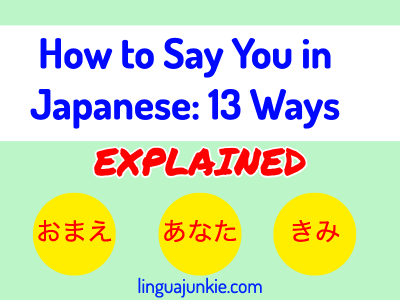Maybe you know how to say I in Japanese…
But, how do you say you in Japanese?
You might’ve heard anata, kimi, omae and other variations. And you probably realized that the meanings and nuances vary. So, it’s natural to wonder about the differences of variations like kimi vs anata or anata vs omae. Anyway, don’t worry.
In today’s guide, YOU will learn how to say YOU in Japanese.
A. How Japanese people use “you”
So, first, let’s talk about “you.”
Not, you you, but you…. the pronoun.
In Japanese, the word “you” is actually unnecessary. You can omit it and still be grammatically correct.

At the same time, there are also many different ways to say you in Japanese — as you obviously know. This concept can be strange for us English speakers. I mean, a sentence in Japanese without the “you” can apply to different people, and you’ll have to figure out who they are talking to based on context.
So, because “you” is unnecessary, Japanese people only say it in specific circumstances and situations. You’ll learn about those below.
To add meaning and context to your sentences, the different words for “you” can show if you’re trying to sound casual, polite, or rude. In general, it’s more natural to say the person’s name directly or omit the pronoun completely. Whenever you’re not sure about which “you” word to use, remember that you can always take out the word “you.” A common mistake among English speakers learning Japanese is to add too many “you” words.
Summary:
- “You” is usually omitted by Japanese people
- Japanese people will use the person’s name instead of saying “you,” or as a way to say “you”
- There are many types of “you’s” in Japanese, but they’re only used in specific contexts
So, let’s look at all the ways of saying you in Japanese.
B. Nice & Casual Ways to Say You in Japanese
In casual situations, you’ll most likely use the person’s name or leave out “you”. Although there are casual words like anata, kimi, or omae, it’s easy to sound rude if you say them to the wrong person.
1) Say their name
Simply using the person’s name is the best way to say you in Japanese. In fact, that’s what you would use instead of “anata,” which is mentioned below.
You should add honorifics like chan or kun to make it sound more friendly. If the other person is a family member or very close friend you could also say their name without honorifics.
2) あなた / Anata
Another way to say “you” is by using anata. You’ll often see anata translated directly as “you,” even though Japanese people don’t use this word that often. There are 2 situations where you can use this word and be nice:
- In a casual context, it is for wives to show affection to their husbands. As in, anata meaning darling.
- You could also use “anata” if you don’t know a person at all. For example, if someone drops a wallet, you could use “anata.” As in, “kore wa anata no saifuu desu ka” (is this your wallet?)
Is anata rude? Yes, it can be considered rude. Especially if you already know that person. Saying “you” is a lot like pointing a finger in someone’s face — it’s too direct in the Japanese language. So, it’s not really used in casual conversations. In fact, anata is included down below in the “rude ways to say you in Japanese.”
3) きみ / Kimi
In many mangas and anime series, this word shows up frequently to mean “you.” However, it’s usually a masculine style of speech used towards those lower on the social hierarchy. It can show a feeling of closeness where the other person is taking care of and looking out for the lower hierarchy person.
If you’re wondering about kimi vs anata…
Remember, kimi is for talking to friends who may be younger than you, or lower in some hierarchy — like for someone in a lower grade. And anata, well, it’s not really used too much with friends.
4) おまえ / Omae
Looking for the omae meaning?
Well…
A casual but slightly rude way to say “you” is omae. This can be said between male friends as a part of masculine speech, and it has a brotherly tone to it. It is super casual and can sound rude, so it’s best to be careful. You wouldn’t want to use it with people you don’t know.
C) Polite Ways to Say You
If you’re trying to be polite, a name or title is the best way to say “you.” Anata could work, but you have to use it in the correct situation.
5) Their Name + honorific
In most polite situations, you’ll want to use the person’s name and an honorific like san or sama. This shows that you respect the other person, and you don’t have to worry about offending the other person. You can choose whether to use their last name or first name. Typically a last name is more polite, and a first name means you already know the other person well.
6) Their Title
Using the person’s title is also a great way to say “you” while respecting their position. For example, you could use the word for a professor (hakase), teacher (sensei), or customer (okyakusan) in place of their name or “you.”
7) あなた / Anata
This word was in the casual section, but it also applies in certain polite situations. You typically only want to use this word when you’re indirectly talking to someone, which only happens in questionnaires and surveys. In most speaking and writing, you should avoid using this word as it can even be rude.
And remember, in a polite setting — you can use “anata” if you don’t know a person at all, and have to get their attention.
D. Rude Ways to Say You
There are many ways to say “you” in a rude way. This is because you usually don’t need to say “you” unless you’re trying to add more meaning. In the case of rude “you” words, you can make phrases sound like an insult just by using them.
8) てめえ / Temee
Temee can be offensive, and you won’t hear it unless people are shouting and fighting. This word feels aggressive, and it’s used primarily by men and shows that you’re looking down on the other person.
9) おめえ / Omee
This might be the omae meaning you’re looking for… if you’re watching anime.
This is a ruder version of omae. It’s not as harsh as temee, but you could also use it in a fight or when you’re angry. It’s also a way for people to talk to sound rougher and manly.
10) このやろう / Konoyarou
One of the rudest ways to say “you” is konoyarou; it means “you horrid person” and can act like a swear word. You can use it in angry contexts when someone has wronged you.
11) きさま / Kisama
Wondering what the kisama meaning is? Well….
It is another rude way to say “you” that you should only use when feeling angry. Since there are many fighting scenes in anime, you might notice the characters using this word in those situations. Like the word konoyarou, it can sound like the equivalent of a swear word in English.
12) きみ / Kimi
Kimi was also in the casual section, but it can also be rude. If you say it to someone who is actually of a higher social hierarchy than you, you could offend them. It can sound like you’re degrading the other person.
13) あんた / Anta
Another way to rudely say “you” is anta. It is an altered version of anata and sounds rude and harsh. Women use anta when they are annoyed at someone or want to show that they are looking down on you. It’s typically not as common for men to use this word.
E. Conclusion: Back to “YOU”
Alright, you…
Now you know all of the fun ways to say you in Japanese.
For the most part, you don’t want to use “anata” and the person’s name instead. That may be the safest approach of all.
Did this clarify your thoughts about all the variations like kimi vs anata and anata vs omae?
Leave a comment!
– The Main Lingua Junkie
